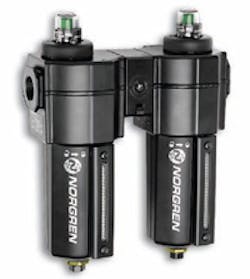Sizing up options for oil-free air
Air leaving a compressor is typically hot, wet, and dirty, and the compressor is also a source of oil contamination within a compressed-air system. A typical 100 scfm (47 dm3/sec) unit can send more than 2 gal(8 liters) of compressor oil into an air system annually.
Oil is needed to lubricate a compressor, but when the oil emerges with the compressed air, the oil is unusable for lubricating downstream components. Having been subjected to high temperatures during air compression, the oil becomes oxidized, acidic, and can be considered an aggressive contaminant, rather than a lubricant, so it must be removed.
Oil in a compressed air system can take three forms: oil/water emulsions, aerosols (small particles suspended in the air), and oil vapor. Standard air filters can remove emulsions, but aerosols and vapor require different treatment.
Normal air line filters will remove sufficient quantities of liquid oil (along with water) to leave the air in a suitable condition to supply most cylinders, valves, and tools, but certain processes demand completely oil-free air.
These include spray painting, food handling, and film and powder processing, where oil could contaminate products or cause defects. Applications that require dry, water-free air often rely on desiccant, deliquescent, or membrane dryers. These devices must be protected from oil contamination to work effectively. Also, oil aerosols can slow the response of downstream devices in critical pressure-control instrumentation.
One solution is to use oil-free compressors. However, these still generate air contaminated with dirt and water. It is often more economical to use lubricated compressors in conjunction with aftercoolers and standard air-line filters, then only fitting high-efficiency, oil-removal filters at the points in the system that demand oil-free air. This setup ensures that the amount of air requiring special treatment is kept to a minimum, thereby reducing system and maintenance costs.
Oil aerosols
Particulate oil droplets in the airstream are most troublesome in sizes ranging from 0.01 to 1 μm. These droplets account for approximately 90% of the oil aerosol, the rest are generally slightly larger.
Most standard air-line filters remove water by centrifugal action but, due to their small particle size, aerosols are unaffected by this action and require special coalescing filters. These filter elements have an extremely fine mesh that intercepts and captures the tiny aerosol particles using three different mechanisms: direct interception, inertial impaction, and diffusion. In direct interception, oil particles simply collide with and are trapped by filter fibers. With inertial impaction, a turbulent air stream throws oil particles against fibers, which trap the oil. And diffusion causes the smallest particles to vibrate and collide with each other — and eventually the element’s fibers — which traps the oil.
These filters also remove minute water droplets, but they must be protected against gross dirt or water contamination by means of standard air filters mounted immediately upstream. These prefilters should remove particles of 5 μm or smaller. Otherwise, the coalescing filter may quickly become choked and blocked with dirt, requiring premature filterelement replacement.
Coalescing filters are normally rated by the amount of air they can “process” while meeting a given oilremoval performance — normally a maximum remaining oil content in the exit air of 0.01 mg/m3 (0.01 ppm). Exceeding rated flow results in a greater pressure drop across the unit (and, therefore, higher energy costs) More importantly, though, the remaining oil content will increase. This may be acceptable for applications where oil removal on the order of 0.5 mg/m3 is adequate to protect a system particularly prone to gross oil contamination.
Oil vapor
Removing oil vapor is unnecessary for most processes because, unlike water vapor, oil vapor exists only in minute quantities. Plus, the oil vapor is not objectionable except in circumstances where its odor is unacceptable – for instance, in food processing, pharmaceutical and beverage production, and breathing-air applications.
The most common removal method is to pass the air through an adsorbing bed, usually of activated carbon, although other materials can be used.
Such vapor-removal filters normally reduce the total remaining oil content — when used in conjunction with a general-purpose prefilter and a coalescing filter — to 0.003 mg/m3. A common misconception is that these filters will remove carbon monoxide or carbon dioxide. They will not.
As with oil-removal (coalescing) filters, good system design ensures vapor removal filters are only installed where needed, the maximum flow rating is not exceeded, and they are preceded by particulate and coalescing filters. This will minimize the required filter size and, therefore, the cost of the installation.
The location of the compressor intake may also have an effect on the level of filtration required if, for example, if the intake is situated near a source of hydrocarbon vapors. Clean air intake will reduce the cost of producing clean, compressed air.
For more information on air filtration, visit www.norgren.com.

Leaders relevant to this article:


